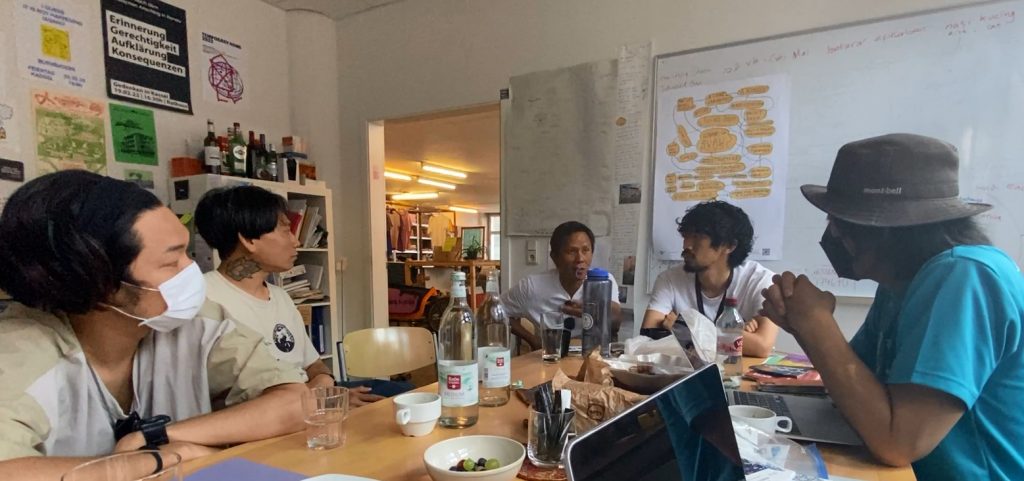
藝大とルアンルパ
藝大最前線は、本学が行う取組を紹介しながら、本学と社会との繋がりや、アートの可能性を伝えていく新コンテンツです。 第二回は、アートの未来と大学の未来について。ドイツ・カッセルで開催中の国際美術展「ドクメンタ15」の芸術監督を務めるルアンルパのメンバーと、日比野克彦学長、今村有策副学長(大学院美術研究科グローバルアートプラクティス専攻(GAP)教授)が、オンライン対談を行いました。
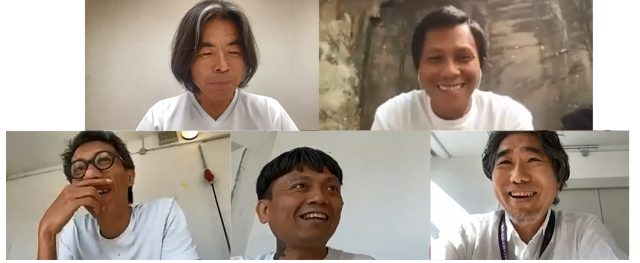 (左上から時計廻りに)日比野学長、ミルワン・アンダン氏、今村副学長、レザ・アフィシナ氏、イスワント・ハルトノ氏
(左上から時計廻りに)日比野学長、ミルワン・アンダン氏、今村副学長、レザ・アフィシナ氏、イスワント・ハルトノ氏
(写真上)ドクメンタ15の本部ルルハウスでミーティング
【はじめに】
世界で最も影響力があると言われる国際美術展、「ドクメンタ」の15回目が今年開催されています。「ドクメンタ15」は展覧会にとどまらず、「Make friends, not art(アートではなく友だちを作ろう)」を掲げて、アートが生まれる人と場所、つながりに焦点を当てています。このドクメンタにGAPが「Composting Knowledge」のメンバーとして参加し、日比野学長の「明後日朝顔」も展開されるなど、カッセルでも新たな繋がりが芽吹いています。
「ドクメンタ15」の芸術監督であるインドネシアのコレクティブ、芸術監督ルアンルパのメンバーのうち、ミルワン・アンダン氏、イスワント・ハルトノ氏、レザ・アフィシナ氏の3名と共に、「ドクメンタ15」が目指したアートと社会の今と未来、そして、藝大が目指す未来を語り合いました。
聞き手:今村有策(東京藝術大学副学長)
何もかも初めてづくし。5年に1度の国際美術展ドクメンタ。
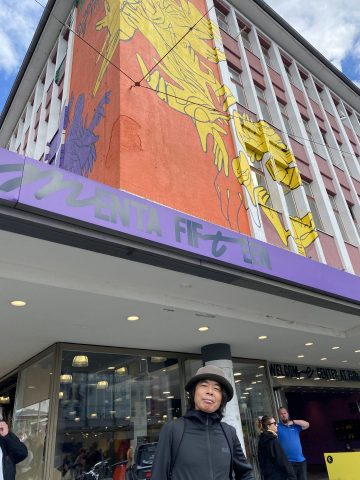 ドクメンタ15の会場を訪れた日比野学長
ドクメンタ15の会場を訪れた日比野学長
2019年2月22日、国際美術展「ドクメンタ」から驚きのニュースが発信されました。これまでドクメンタといえば、パワーキュレーターたちが世界の潮流を5年に一度世に知らしめるという形で行われてきましたが、2022年の開催は、個人ではなく、初めてコレクティブ・アーティストが迎えられ、ルアンルパによりキュレーションされることが発表されました。ドクメンタ初のアジア出身の芸術監督です。
ルアンルパは2000年にインドネシアのジャカルタでアーティストたちによって形成されたコレクティブです。活動の母体はすでに90年代後半にあり、その背景には97-98年におけるアジア通貨危機をきっかけに大きな失業やインフレが生まれた社会危機と、98年のジャカルタの学生運動から始まった反政府デモ、スハルト退陣がありました。既存の社会制度に疑問を持ち、自分たちで新たなシステムを作り上げるために共同して活動が始まりました。
彼らの活動は、アーティスト、キュレーター、エディター、教育者、アクティビストと幾つもの側面をもっています。メンバーの誰もが領域に区切りを持たずに活動し、アートスペースの運営、展覧会やワークショップ、リサーチプロジェクトから、OK video festivalなどの国際展の企画運営に加え、アートショップやコミュニティラジオ局RURUradioなども展開するなど、その活動は多岐にわたります。
近年では、本格的な学校づくりに取り組みGUDSKULを開設。設立当初は6人でしたが、他のコレクティブとの共同も始まり、19年を経た現在では30名もの活動に広がっています。
「ルンブン=お米の倉」はソーシャル・プラットフォーム
ドクメンタ15でルアンルパが提案するコンセプトは「ルンブン(LUMBUNG)」。その「ルンブン」はインドネシア語で「お米の倉」を意味します。「ルンブン」は、共同体で生産された米が未来の共有資源として貯蔵される場所です。ルアンルパメンバーのミルワン・アンダン氏は、「ルンブン」は、収穫した米を貯蔵し、それをコミュニティで分け合うように、皆でシェアするプラットフォームであり、予算、設備、会場など物質的なインフラだけでなく、参加者たちの知識やノウハウもシェアすることだと説明してくれました。
「2018年にドクメンタに芸術監督として招待された私たちは、逆に、『ルンブン』にドクメンタを招待することから始めました。
私たちは『ルンブン』をソーシャル・プラットフォームのようなソフトウェアととらえて、『ルンブン』を通じて、様々なアート活動をどう維持するか、そして『ルンブン』自体をどう持続可能なものにしていくかを考えました。
何をするかだけでなく、どうやってやるか。内の組織だけでなく、外の人達、周りの環境やコミュニティと一緒に、イベント、展示内容、仕組み作りなど、『ルンブン』を構築するために、話し合いを続けていく。そのプロセス全体もすごく重要だと思います。それは一緒にいる仲間と楽しい時間を過ごす場でもあるんです」
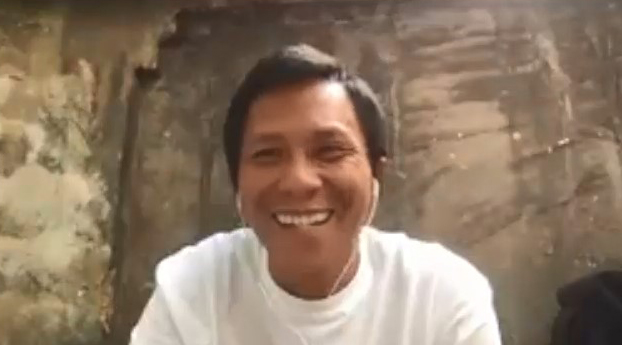 ミルワン・アンダン氏
ミルワン・アンダン氏
「ルンブン」の考え方に基づいた「エコシステム」
彼らのやり方は、今までのトップダウン型のキュレーションとは一線を画すものでした。「ドクメンタ15」では「ルンブン」の考え方に基づいた「エコシステム」があります。これが目指しているものは、自然界のような異なる種が共同体へ還元し循環するもの。招待作家はアーティスト個人ではなく、アーティストはその周りのエコシステムも含めて招待され、みんなで一緒に活動をします。エコシステムの一環として7月にドクメンタに参加した日比野学長は、その様子を振り返ります。
「世界中のアートコレクティブがカッセルにどんどん入ってきていました。他者とのコラボレーションといった『友だちをつくる』という状況は、コンセプトのとおり実践されていて、そこから多くのことを学べました」
アーティストを招待するにあたり、ルアンルパのメンバーは「ルンブン」のコンセプトに基づき7つの価値「generosity(寛大さ)」「local anchoring(ローカルアンカリング)」「humor(ユーモア)」「frugality(倹約)」「regenerative(再生的)」 「transparency(透明性)」「independence(独立性)」を掲げ、こういった価値観を共有しあえるかを模索しながらアーティストとの対話を続けてきたとアンダン氏は言います。
「みなさんもご覧になったとおり、たくさんのアーティストが自分の周りのエコシステムや友人と一緒にやってきて、様々な価値が持ち寄られました。新しい友だちができて、その輪がどんどん広がっていった。『ルンブン』という実験はドクメンタ15のプロセスに関わってくれた様々な人たちみんなの関係性の中で続いていくでしょう」
明後日朝顔
「今の話は、「after 100 days」につながりますね。持続させる活動自体を「after 100 days」として『ドクメンタ15』の表現として発表するのがすごく画期的だと思いますし、私もそのエコシステムの末端として呼んでいただき、『明後日朝顔』がつながりました」と、日比野学長は感謝を述べつつうれしそうに語りました。
|
||||
メンバーのイスワント・ハルトノ氏は、100日の開催期間を終えたあとも、『ルンブン』を持続させる「after 100 days」のために、2年前から実際にカッセルに住んで活動をしています。
藝大公開講義~:知識と経験を共有することに参加する形と場
3年前に藝大で行った公開講義「スペース: 知識と経験を共有することに参加する形と場」(2019年10月17日開催)では、ルアンルパのイスワント・ハルトノ氏とレザ・アフィシナ氏の2人が来日し、藝大の学生と、自分たちの未来について語り合いました。
「ルアン」が場と空間を意味し、「ルパ」が形作ることを意味するように、ルアンルパは新たな場の形成を試みて、そのプラットフォームは歴史や政治や多様な社会の問題をアーティストのセンシティビティによって見直すものです。彼らの活動はフレキシブルで有機的で、60年代のような一度きりのムーブメントではなく、新しい有機的な動きが、いかに持続可能でローカルでかつグローバルなものであり得るかという新しいコレクティビティを問いかけています。
大きな視野でアートと社会を考え、攻撃よりも友を作ることに意義を見出す活動は、公開講義を聞いた学生にとって、示唆のあるものでした。
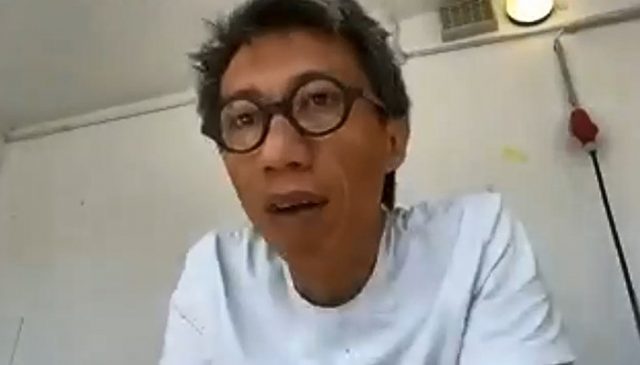 イスワント・ハルトノ氏
イスワント・ハルトノ氏
藝大の学生と話したことが、エコシステムで繋がっていく
イスワント・ハルトノ氏は語ります。
「『ルンブン』の実践をどのように持続していくかについては、実は3年前に藝大を訪れた際に藝大の皆さんとも話をしました。今まさにそれを具体化しているわけです。カッセルにアーティストやその仲間たちが来てくださり、これから再び元々の場所、それぞれのローカリティやエコシステムに戻っていきます。今村さんやGAPの学生さんたちもそうです。それは『Composting Knowledge』というネットワークがどのように広がっていくかにつながります」
「Composting Knowledge」は「ドクメンタ15」の知識生産のための実験的ネットワーク。本学のGAP専攻も参加しており、その連携としてショートユニットを開催しました。「ドクメンタ15」では交流を通じて生まれた出会いや議論を「ハーヴェスト(=収穫)」と呼び、その収穫は大学も含め社会の中で還元されていくことを目的としています。ハルトノ氏はGAP専攻との活動をこう振り返ります。
「藝大のアーティストや学生たちが来てくれて、ヨーロッパや日本やインドネシア、それぞれの文脈のなかでみんなが共有したことが、その後どんなふうに広がり育っていくかを考えると、多層的なことが起きると思います」
未来なんだけど、なつかしい
東日本大震災の後にも「なつかしい未来」という言葉がありました。今回のドクメンタが提示する私たちの未来は、どこかなつかしいものです。「未来なんだけど、なんかなつかしい」。私が「ドクメンタ15」を通して得たのはそんな感覚でした。藝大のように歴史や伝統を持っていることが、実は未来を作っているのではないでしょうか。日比野学長はルアンルパのドクメンタ芸術監督就任を変換期と位置づけます。
「ヨーロッパ=西洋が学問として美術史を作ってきて、その中で東洋やアフリカ、プリミティブアートを参考にしてきた。現代アートとしてドクメンタがルアンルパを採用したことが変換期だと思います。そういう意味でも『なつかしい』というのが、しっくり来る。アートの役割をアジア的な思考に求めているのは、アートの本道のところにアジアの思考、『ルンブン』的な考え方が生まれてきたからなのかなと思います」
ルアンルパは西洋的なものを否定するのではなく、あくまで自分たちの考えに基づいて活動しています。ドクメンタに招待されたアーティストも、国名の表記はなく、グリニッジ標準時との時差(タイムゾーン)だけが示されました。アートにとって国境はありません。
「アートは日常の中にあるものだけど、きちんと集めて文脈を見せ、価値を交換し合う。そうするとお互いが出会うことによって自分らしさがわかる。今回のドクメンタでは、権力のもとに集まったプラットフォームや国境ではなく『タイムゾーン』という「国境ではないもの」で区分され、アートの価値や、その人、その地域らしさに目を向けさせています。人間が作った境目にこだわっていると、いつまでたっても争いはなくならない訳ですから。」
日比野学長の言葉は、ルアンルパと同じインドネシア出身のアグス(Agus Nur Amal PMTOH)というアーティストが、ルアンルパにアドバイスしたことと繋がります。「絶対に西洋と同じやり方で抵抗してはだめだ。署名を集めたり意見書を提出したりデモをしたりしてはだめだ。とにかく俺たちがハッピーで俺たちが友だちなんだということをみんなに感じてもらう以外にやり方はない」と。西洋的に見れば弱いやり方なのかもしれないけど、弱いやり方だから実は本来的で強いんだと。
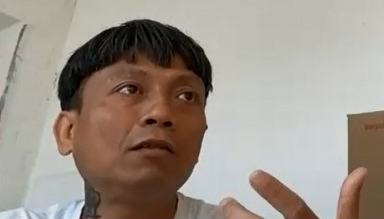
レザ・アフィシナ氏
困難や問題点を自分たちの声で明言すること
ルアンルパのメンバーの一人、レザ・アフィシナ氏は、様々な困難や問題について考える、そのプロセスを自分たちの声で明言することが大事だと言います。
「我々のコレクティブでは、困難や問題の中でもがき苦しんできたことが共有されます。そしてコレクティブがどういうコミュニティに関わっているのか、コミュニティとはそもそも何なのかといった、様々なアングルから問題点があぶり出されます。一番大切なのは、そのプロセスを自分たちの言葉で語ることです。
社会の中には様々な共同体に関する歴史やアーカイブがありますが、アートコレクティブのアーカイブはあまりないようです。オルタナティブな活動やアートコレクティブを社会の中にマッピングすることは、2000年代当初からアジアでも行われてきました。個々の点としては見えるようになったけれど、それが線で結ばれ、歴史という文脈の中でつながるには至っていません。これからはその物語を紡いでいくことが必要になるでしょう。そういう意味で、我々の活動は未来に向かっているけれど、過去から脈々と続く物語の一部です。だから、今村さんがおっしゃったように『なつかしい』感じがするのだと思います。
社会もアートコレクティブも、ウィルスも日々変化しており、パンデミックは未来を考える上で大きな鍵になっています。その中から我々が何を学ぶか。日比野先生が進めている朝顔のプロジェクトも深く関わっていると思います。朝顔を育てることを通じて人や地域、そして過去・現在・未来がつながる。パンデミックの新しい景色のなかで、種というものが何を伝え、どんな意味を持つのか皆で考え、学んでいくことが大事だと思います」
芸術の役割を考え、世界中の人たちと課題に取り組む
「ドクメンタで僕らがやっていることはリハーサルなんです。未来のためのリハーサルなのです」というレザ・アフィシナ氏の発言がとても心に残りました。今後の藝大の、そしてアートの方向性を考える上で大切なことです。
日比野学長は対談の最後にこう語りました。
「藝大でも、“藝大がさまざまな困難や問題点に何ができるか”、“アートが社会的な課題に対してどう取り組んでいくべきか”を模索しています。これからは、世界中にあるアートの専門機関とそれぞれの国が一つになっていくことが必要です。藝大だけで頑張るのではなく、世界中の芸術大学、世界中の企業とともに、世界中で抱えている課題に対して取り組んでいきたいと思います。自分も、一人のアーティストとして何ができるか。社会におけるアートの役割を見いだし、発信していきたいですね。」
今年から、ヨーロッパやアジアの芸術大学が共同で社会課題などのテーマに、国や地域、文化・歴史的背景の差異を超えて取り組む「Shared Campus」 という、国際的な教育形態と研究ネットワークのための協力プラットフォームに加わりました。これからもさまざま機関と連携し、グローバルな視野を持って課題に取り組んでいきます。
 左:日比野学長 右:(左から)今村副学長、イスワント・ハルトノ氏、今村宙幹氏
左:日比野学長 右:(左から)今村副学長、イスワント・ハルトノ氏、今村宙幹氏
【おわりに】
今回のルアンルパによるドクメンタ15は、ドクメンタをはじめとする国際展がこれまで世界の一握りのアーティストたちの作品や活動、その結果が紹介されていたのと異なり、各地の多くのアーティストの活動とそのローカルの環境がカッセルに集まり、それが共有されていくプロセスそのものを国際展として提示していました。それは実験的でもあり、しかし同時にアートが生まれていくそのプロセスそのものを提示する本質的なものでした。大学も本来、このアートが生まれるプロセスそのものを大切にする場です。結果や評価だけを重要視するのではなく、ルアンルパがエコシステムと呼ぶ、アートが生まれるプロセスそのものにこそ、もう一度眼を向ける必要があると再認識しました。ルアンルパが考えるafter 100daysについて私たち藝大も一緒に考え、活動し、アートの未来、アートと社会の未来、そして芸術大学の未来を考えていきたいと思います。(今村有策)
通訳:今村宙幹、ヤマモト アン・トモコ
協力:大学院美術研究科グローバルアートプラクティス専攻(GAP)、グローバルサポートセンター
企画:藝大SDGsプロデュース・ユニット
Tokyo Geidai and ruangrupa
藝大最前線 Geidai Saizensen (Geidai Front Line) is a new column that introduces Tokyo Geidai’s endeavors while delving into the potential of art and the university’s connections with society. This second article is about the future of art and the university. Tokyo Geidai President Katsuhiko Hibino and Vice President Yusaku Imamura (Professor in the Global Art Practice MFA Course, GAP below) engaged in an online discussion with members of ruangrupa, who are Artistic Director of documenta fifteen, the international art exhibition currently underway in Kassel, Germany.

Clockwise from top left: Katsuhiko Hibino (Tokyo Geidai, President), Mirwan Andan (ruangrupa, member), Yusaku Imamura (Tokyo Geidai, Vice President), Reza Afisina and Iswanto Hartono (ruangrupa, members)
Top photo: Meeting at ruruHaus, the central space for documenta fifteen
Introduction
This year marks the fifteenth iteration of documenta, said to be the world’s most influential art exhibition. Documenta fifteen goes beyond exhibitions to focus on connections between people and places created by art under the concept “make friends, not art.” New connections blossoming at Kassel include GAP’s participation in Composting Knowledge and the presentation of President Hibino’s “The Day After Tomorrow Morning Glory” project.
This conversation was conducted with Mirwan Andan, Iswanto Hartono and Reza Afisina, members of the Indonesia-based art collective that serves as Artist Director of documenta fifteen. The conversation covered documenta fifteen’s vision for the present and future of art and society as well as Tokyo Geidai’s vision for the future.
Interviewer: Imamura Yusaku (Tokyo Geidai, Vice President)
First Time for Everything at the Quinquennial Documenta Exhibition
 President Hibino at documenta fifteen
President Hibino at documenta fifteen
On February 22, 2019, a surprising announcement came from documenta, the international art exhibition. Previous iterations had served as once-every-five-year signals on global trends from power curators. For the first time, the 2022 edition selected an art collective, and the first Artistic Director from Asia.
ruangrupa is a collective formed in 2000 by artists in Jakarta, Indonesia. The genesis of their activities can be traced back to the late 1990s, which saw inflation and mass unemployment triggered by the 1997 Asian financial crisis, anti-government riots sparked by student activism in Jakarta, and the resignation of President Suharto. Artists harbored doubts about the existing social system and began taking collective action to build a new system on their own.
The collective is comprised of artists, curators, editors, educators and activists. Members are not confined to specific roles, and their wide-ranging projects include art space management, exhibitions and workshops, education, research projects, international exhibitions such as the OK. Video festival, an art shop, and the community radio station RURUradio.
In recent years they opened GUDSKUL as a learning space. There were six people when it was founded, and collaborations with other collectives over the past 19 years have expanded the group to more than 30 members.
Lumbung = Rice Barn as a Social Platform
ruangrupa proposed the concept of “lumbung” for documenta fifteen. The term means “rice barn” in Indonesian and serves as a place for storing and sharing rice created by the community as resource to be shared. ruangrupa member Mirwan Andan explained lumbung as a collective platform for sharing not only budgets and physical infrastructure like facilities and exhibition venues, but also members’ knowledge and knowhow.
Andan elaborated: “In 2018 we were invited to documenta as Artistic Director, and our first step was to invite documenta to join the lumbung. We conceived of the lumbung as software like a social platform and considered how to sustain various artistic activities and make the lumbung itself a sustainable entity. We considered not just what we would do, but how. Discussions are continuous because the lumbung consists of events, exhibitions and systems created by the art collective, outside friends, and the surrounding environment and community. That entire process is very important. The lumbung is also a place for hanging out with friends.”
 Mirwan Andan (ruangrupa, member)
Mirwan Andan (ruangrupa, member)
“Ecosystem” Based on the “Lumbung” Approach
Their approach was a departure from previous top-down curation. Documenta fifteen has an ecosystem based on the lumbung way of thinking. The aim is a cycle in which diverse elements contribute to the collective as seen in the natural world. Artists are not invited as individuals, but rather together with their surrounding ecosystems, and everyone works together.
President Hibino joined that ecosystem at documenta in July and recalled that “art collectives from around the world gathered in Kassel. I learned a lot from the situation of making friends through collaborating with others and experienced the concept as realized in practice.”
When inviting artists, the ruangrupa members discussed seven values based on the lumbung concept, generosity, local anchoring, humor, frugality, regenerative, transparency and independence. Andan discussed how they searched for ways of sharing these values with artists through ongoing discussions, commenting: “As you have seen, many artists have come with their own ecosystems and friends and have brought together various perspectives. We made new friends and that circle continues to expand. The lumbung experiment continues within the relationships created by the many people involved in the documenta fifteen process.”
The Day After Tomorrow Morning Glory
President Hibino further commented, “this is related to the concept of ‘after 100 days.’ It is groundbreaking to present as documenta fifteen as activities to be sustained ‘after 100 days,’ and ‘The Day After Tomorrow Morning Glory’ joined as part of that ecosystem.”
|
||||
ruangrupa member Iswanto Hartono began living in Kassel two years before documenta fifteen as part of the “after 100 days” effort to make the lumbung sustainable beyond the exhibition period.
Tokyo Geidai Open Lecture:
Space as a form and place where we take part in distributing knowledge and experience
Three years ago ruangrupa members Iswanto Hartono and Reza Afisina held an public open lecture at Tokyo Geidai titled “Space as a form and place where we take part in distributing knowledge and experience” (October 17, 2019) and discussed the future with students.
“ruang” means field and space while “rupa” means form. This collective is trying to form a new space – a platform where artists use their sensitivities to review diverse issues in society, history and politics. Their flexible and organic activities ask how new collectivity can be sustainably local and global and not end like the one-time movements of the 1960s. Their visionary ideas about art and society and activities that find meaning in friendship were suggestive for the students in attendance.
 Iswanto Hartono (ruangrupa, member)
Iswanto Hartono (ruangrupa, member)
Ecosystems Link the Ideas Discussed with Tokyo Geidai
Iswanto Hartono continued: “In fact, when we visited Tokyo Geidai three years ago we talked about how to make the lumbung practice sustainable. And now it is taking form. Artists and their friends have come to Kassel and then return to their own localities and ecosystems, just like Professor Imamura and the GAP students. This leads to the expansion of the Composing Knowledge network.”
Composting Knowledge is an experimental network for knowledge production at documenta fifteen. Tokyo Geidai’s GAP is participating and conducting an associated short unit project. The discussions and encounters that emerge through documenta fifteen are referred to as the “harvest,” and the aim is to give that harvest back to society, including the university.
Hartono reflected on the GAP activities as follows: “Students and artists from Tokyo Geidai have come to Kassel and people have shared things from their own cultural contexts, including Europe, Japan and Indonesia, and will then spread and cultivate those things. I think we will see multilayered things happen.”
Nostalgia for the Future
The phrase “nostalgic future” emerged after the Great East Japan Earthquake in 2011. The future as proposed at documenta fifteen somehow feels nostalgic. That is what I learnt from documenta fifteen. Having history and tradition like Tokyo Geidai could be in fact going to create the future.
President Hibino frames ruangrupa’s appointment as Artist Director as a transition period, commenting as follows: “Europe, or the West, created art history as an academic field with reference to Asia, Africa and primitive art. I view documenta’s appointment of ruangrupa as a period of change. Which makes the feeling of ‘nostalgia’ hit home. I think asking for an Asian approach to the role of art has happened because the lumbung approach, an Asian approach, has emerged from mainstream art.”
ruangrupa doesn’t negate Western influence, but rather they base their activities on their own ideas. The artists invited to documenta fifteen are only identified by their GMT time zone and not country name. Art has no borders.
President Hibino commented: “Art exists in everyday life, but it needs to be brought together, contextualized and values need to be shared. Then each party comes to better understand their own unique qualities. At this documenta, artists were classified by borderless time zones instead of nationality or authority-based platforms. This makes us aware of the value of art and the unique aspects of each person and region. War will continue as long as we keep focusing on manmade boundaries.”
President Hibino’s comments connect with advice given to ruangrupa by Indonesian artist Agus Nur Amal PMTOH: “You must not resist in the same way as the West. Don’t do petitions, submit position statements or hold demonstrations. The only way forward is to have everyone understand this happiness and friendship.” His point is that it might seem like weakness from a Western perspective, but this weakness is actually strength.

Reza Afisina (ruangrupa, member)
Stating Issues, Problems, and Difficulties Shared in Our Own Voices
ruangrupa member Reza Afisina commented on the importance of thinking about problems and difficulties by voicing the process in their own words, as follows:
“In our collective, if we suffer through difficulties, that also gets shared. And problems multiply depending on how the collective gets involved with communities, the meaning of community, and many other issues. The most important thing is to talk about that process in our own words.
“There are archives and histories for many types of organizations, but not for art collectives. Alternative activities and art collectives have been mapped in society since the early 2000s in Asia. The collectives became visible as separate entities, but they have yet to be connected within the context of history. Now we need to weave those stories together. In that sense, our activities are heading toward the future, but are part of stories that continue from the past. So I think it feels ‘nostalgic,’ as Professor Imamura commented.
“The pandemic provides important keys for thinking about the future, as viruses evolve on a daily basis, alongside societies and art collectives. What is there for us to learn? I think the answer is deeply connected with President Hibino’s morning glory project. Cultivating morning glories connects people and localities, and the past, present and future. It is important for all of us to consider the meaning of ‘seeds’ within the new landscape of the pandemic.”
Addressing the Role of Art with People Around the World
Reza Afisina’s comment that “we are doing a rehearsal at documenta. This is a rehearsal for the future” left a deep impression. It is important when considering the future direction of Tokyo Geidai, as well as art.
President Hibino commented, “At Tokyo Geidai we are also considering the university’s responses to numerous issues and how art can engage with societal problems. Each country’s art institutions need to work in concert. At Tokyo Geidai we want to join forces with other art universities and corporations to address global issues. What can I do as an individual artist? We want to explore and extend the role of art in society.”
This year Tokyo Geidai has joined Shared Campus, a cooperative platform for international educational networking that transcends differences in geographic, cultural and historical backgrounds with a shared focus on social issues with art universities in Europe and Asia. I hope to join with you all in this global conversation on the future shape of the university.
 Left: President Hibino
Left: President Hibino
Right: (from the left) Vice President Imamura, Iswanto Hartono, Tyuki Imamura
Afterword
Documenta fifteen under ruangrupa’s artistic direction differs from previous international exhibitions that have featured select global artists and their work. It has convened in Kassel the activities of many art collectives and artists from diverse places alongside their local environments, and has presented that collective process as an international exhibition. This experimental endeavor has been an authentic display of the process through which art is born. The university is a place that values the process through which art is created. I have recognized once again the need to reconsider the process of artistic creation, which ruangrupa refers to as an ecosystem, and not only prioritizing outputs and evaluations. At Tokyo Geidai we hope to join ruangrupa in their “after 100 days” activities to consider the future of art, art and society, and art universities. (Yusaku Imamura)
Interpretation: Tyuki Imamura, Ann Tomoko Yamamoto
Cooperation: Tokyo Geidai Global Art Practice MFA Course, Global Support Center
Planned by: Tokyo Geidai SDGs Unit





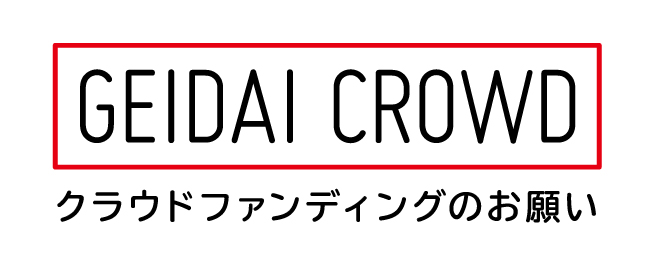







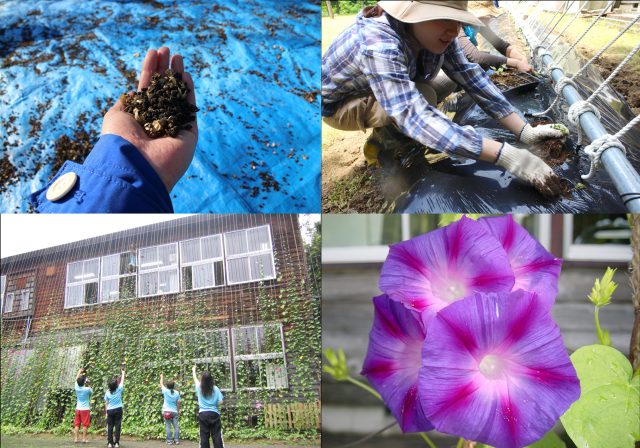
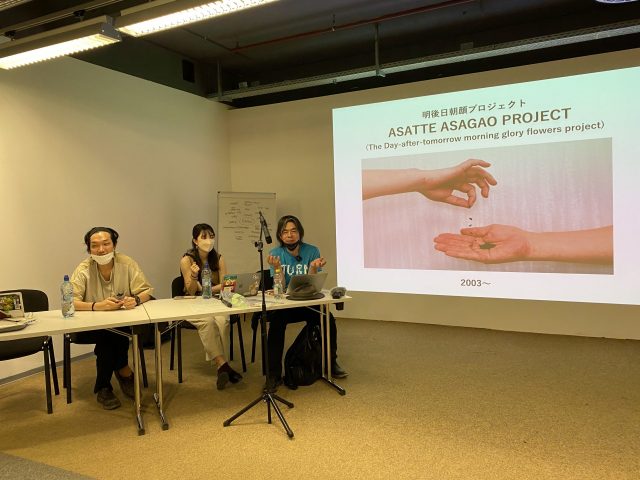 ドクメンタ15での「明後日朝顔」のプレゼンテーションの様子
ドクメンタ15での「明後日朝顔」のプレゼンテーションの様子